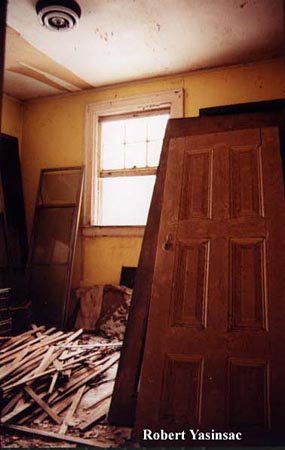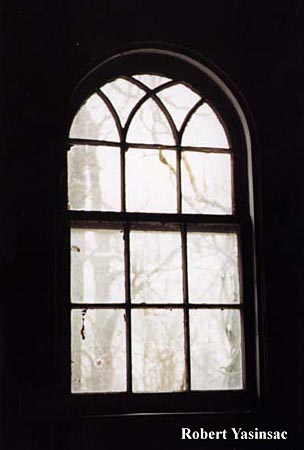Browning/Green Mansion, January 19, 2000
Five minute exposure, at night.
Gracemere
TARRYTOWN, NY
Browning/Green Mansion, January 19, 2000
Five minute exposure, at night.
Crowning one of Tarrytown's many
hilltops is an estate called Gracemere. The estate lies some inland from
Broadway and even further from the Hudson River, lending it an air of privacy
not found at homes just a stone's throw from the bustling bustling thoroughfare
and the intrusive Hudson River railroad tracks. The main estate house, Gracemere
Hall, is a rough hewn granite structure with a mansard roof and was probably
built just before the Civil War, if not as early as 1850.
A map of 1901 shows the 79 and 3/4 acre property as belonging to a
Charles Graef, who acquired the property from a Robert Graves. Although ignored in the many notable books on local architecture and Hudson Valley
mansions, the house was shown in other publications. An advertisement in Country Life
(December 1903) for an electrical lighting company in New Rochelle proudly shows Gracemere, the residence of B. C. Graff, esq.
Woolen-goods manufacturer Henry King
Browning purchased the estate about 1910 from the Graff family. It has been
written that Browning's company
produced uniforms for the United States Armed forces in World War I. Henry
Browning and his wife had four daughters. Upon their marriages, he built a
mansion on the estate for each newlywed couple. Three of these houses are still
standing and continue to be used as residences. The fourth, depicted on these
pages, was demolished
sometime around 2006; it had been abandoned for a few decades prior.
The abandoned mansion on the estate was built for “Miss Adelaide” and Stuart Green,
who was mayor of Tarrytown from 1933 to 1937. (The other daughters married into
the Dickinson, Thurber and Small families.) The house had Colonial Revival architectural features, including a gambrel
roof with pedimented dormers on the north and south sides. other features of
the mansions elegant past were long removed even before the salvagers and
wreckers came by, including the eastern portico, the enclosed porch on the
west end of the house.
It seems there was once a point in time when this house was almost-not
abandoned. Apparently a renovation job was cancelled halfway through; the upper
floors of the house were largely stripped leaving only the exposed wood frame
behind. It seems a new roof was installed, but foam insulation was left behind
in its original packaging. Doors were taken off their hinges and stored away in
one room, while kitchen appliance, bathroom fixtures, cabinets and a couch were
left to while away years of abandonment in the wood-paneled living room and its
addition. Pipes cluttered the main hall floor, while a fireplace mantel uprooted
in the dining room caught my fancy for years before it likely went to an
antiques dealer.
Henry King Browning died in 1938, and one of
his daughters remained at her house at least through the 1970s. Once comprising
about 80 acres, the estate has been parceled off. A large amount of the original
property is still owned by the Holy Spirit Association for the Unification of
World Christianity. Followers of the Reverend Sun Myung Moon belong to this
organization otherwise simply known as the Unification Church.
Except where otherwise noted,
photographs on this page were taken January 20, 2000.



Yaz’
Hudson Valley Ruins and Abandoned Buildings, etc.
E-mail Rob Yasinsac
This page copyright © 2000 by Robert
J. Yasinsac.
Reproduction or copying of these photos in any form without the permission of
Robert Yasinsac is not permitted.